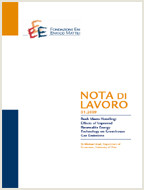Intellectual Property and Biodiversity: When and Where are Property Rights Important?

07.11.2011
Mare Sarr, Tim Swanson
Q56, O34, L24
Biodiversity Prospecting, Traditional Knowledge, Genetic Resources, Intellectual Property Rights, Sequential R&D
Climate Change and Sustainable Development
Carlo Carraro
An important issue in the life sciences industries concerns the nature of the incentive mechanism that should govern the production of innovation within this R&D sector. We look at the specific problem of coordinating the supply of inputs across very different agents – North and South – that must each supply inputs in order to generate innovations from the industry. The current arrangement in this industry provides for a single property right at “end of the pipeline”, i.e. where marketing of the innovation occurs. This property rights scenario raises two problems, one of efficiency and one of equity. The key question asked here pertains to the number and placement of property rights that should be instituted to address this property rights failure. Should one establish new property rights in traditional knowledge alone; property rights in genetic information alone; or in both? We demonstrate that in a world in which traditional knowledge and genetic information are complements in the production of R&D, a resolution of the property rights failure in genetic information also may resolve the allocation failure in traditional knowledge even in the absence of a distinct property right. The reason is that traditional knowledge of the nature of private information is comparable to a trade secret. Traditional knowledge holders may use this informational advantage to improve their benefit by capturing some informational rent. A new property right is important to enable bargaining and coordination to occur across the industry, but a single property right is probably sufficient to enable coordination between the two agents.
